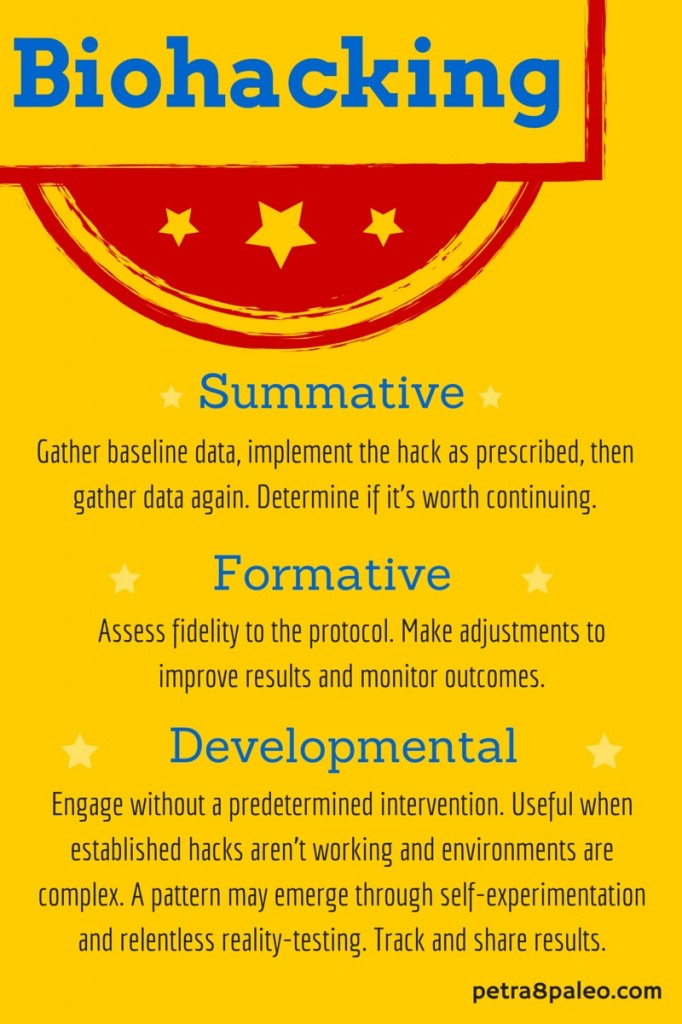My name is Petra-Chambers-Sinclair and I’m a devout evaluation nerd and Biohacker from Victoria, British Columbia. Fellow evaluators understand when I explain that, as a Biohacker, I apply evaluative thinking to my personal life with the goal of maximizing my well-being. I run nutritional and lifestyle experiments, and then use data to fine-tune the strategies I use to achieve my goals.
Hot Tip: An evaluative mindset is all that Biohacking requires.
Summative Evaluation
Biohackers use summative evaluation when following an established dietary protocol or a lifestyle hack, such as one aimed at reversing autoimmune or improving sleep quality. Biohackers first gather data for the baseline, then engage with the protocol as prescribed, and gather data again at the end. As with any summative evaluation, the final stage is determining if it’s worth continuing with the hack.
Formative Evaluation
If, after engaging in a nutritional or lifestyle hack for a reasonable length of time, desired interim results aren’t being realized, biohackers assess fidelity to the protocol. If fidelity is perfect, formative adjustments can be implemented and subsequent results monitored.
Developmental Evaluation
Developmental Biohacking enables learning and engagement when there is no predetermined intervention; when conditions are complex and causality is hard to track. It enables biohackers to develop an intervention inside the mess of real life. Biohackers go developmental when nothing else seems to be working and when environments both inside and outside the body are unpredictable, such as with health issues that no one can explain or offer effective treatment for. Gradually, through self-experimentation and relentless reality-testing, an intervention might emerge that can be evaluated formatively or summatively. In the meantime, developmental evaluation allows for interaction, observation and adaptation.
The internet has allowed people who are innovating in this way to communicate the results of their experiments with each other, enabling Developmental Biohackers to accelerate learning & pattern-finding, thereby creating highly effective and scaleable interventions, such as the Autoimmune Protocol. Biohacking blogs remain a primary source of developmental information.
N=1
An N=1 is an experiment with one participant.
The assumption inherent to N=1 in the Biohacking world is that universal solutions to complex health problems have limited effectiveness, as we each have unique histories, genetic profiles, environments, and patterns of responding.
We are complex systems living in complex systems.
And an evaluative mindset is all we need to leverage this complexity on behalf of increased health & well-being.
Rad Resources:
- A Beginners Guide to Biohacking by Mark Moschel https://www.bulletproofexec.com/beginners-guide-to-biohacking-101/
And another one, if it’s not considered self-promotion:
- Biohacking: the ultimate New Year’s Resolution (because it’s not too late to make one!) http://petra8paleo.com/2014/12/26/biohacking-the-ultimate-new-years-resolution/
Do you have questions, concerns, kudos, or content to extend this aea365 contribution? Please add them in the comments section for this post on the aea365 webpage so that we may enrich our community of practice. Would you like to submit an aea365 Tip? Please send a note of interest to aea365@eval.org . aea365 is sponsored by the American Evaluation Association and provides a Tip-a-Day by and for evaluators.


Pingback: The Theoretical Lineage of Biohacking | The Happy Diet
Pingback: The Theoretical Lineage of Biohacking | petra8paleo
Pingback: Biohacking Tip #2: Scientific Method | petra8paleo